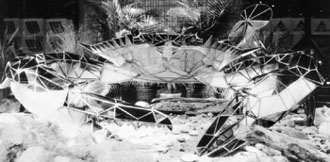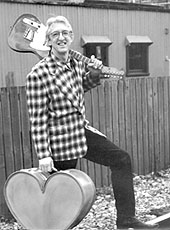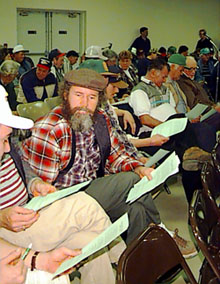
Dock of the Bay

Volume VII Number 4
January 28-February 3, 1999
In Spat-Spiced Saga, Shady Side Crab to Return to BWI
You may have seen this crab. Callinectes sapidus
douglassi is about five feet tall, 10 feet long and 400 pounds heavy. Crafted
in 1984 from 5,500 clear, blue, white, green and red panes of stained glass
clad to an iron frame, it's greeted millions of travelers from its prominent
perch in the terminal at Baltimore-Washington International Airport. The
sculpture praised by critics and admired by passersby has reportedly been
appraised for a low value of $150,000 and a high of $400,000.
But you won't have seen it lately. Callinectes sapidus douglassi is missing.
To have seen this one-of-a-kind blue crab, you'd have had to have travelled to BWI between the years 1985 and 1996. But not between 1992 and 1993, when it was first removed to make way for renovations. In '96, it was moved again to stay clear of expansion construction. Now, in 1999 with the expansion complete, the crab still hasn't returned and people are asking where it's wandered off to.
"We hope to have it back within 90 days," said Jerry Klasmeier, Anne Arundel County's chief administrative officer, in an interview last week. "I am greatly anticipating its return. People really like it."
As it turns out, the crab has suffered injury in the way of cracked glass and accumulated filth. Klasmeier and the county believe the cracks resulted from structural stress.
"I wonder if he has stress cracks in his glasses, this guy," said Shady Side's Jackie Leatherbury Douglass. "It would have been perfect if it had been taken care of by people who cared about it."
Douglass is passionate on the subject, and for good reason. Callinectes sapidus douglassi is her creation.
For 14 months she and her husband, John, labored to create an unprecedented massive, three-dimensional glass crab. After it was installed, the pair returned of their own free will to clean it regularly. The sculpture was commissioned by the county to draw attention to the economic potential of Anne Arundel.
"Obviously, it was originally commissioned as a tool for economic development," said Klasmeier. "But you can't look at it and not consider it a work of art."
Such a synopsis doesn't sit well with the Douglasses, who never approached it as a simple centerpiece for display. "We weren't commissioned directly by the county but by a man named Urgo, who told us he wanted a 'Tiffany of a piece,'" said Jackie Douglass. And that's what they delivered.
The conceptual rift is but the beginning. When the county took bids for repairing the crab, Douglass lost to Baltimorean Lucinda Shaw - who bid $5,000 against Douglass' $18,000 (the original cost of the crab). By Douglass' estimation, fixing the crab requires taking it apart completely, cleaning it thoroughly and replacing broken panes with special glass purchased in New York. At not being able to repair it herself, Douglass' exasperation has peaked.
Shaw, if keeping to her post-back surgery schedule, has already begun repairs. Though it's too late for Douglass to be her crab's savior, she still wants a part in bringing Callinectes sapidus douglassi back. "I'd like to show [Shaw] where to get the glass, where the trap doors are and everything," said Douglass.
But what the Shady Side artist really wants is to get the attention of the county. "I'd really like to speak with Mrs. Owens and the man she has in charge," said Douglass.
The crab returns home to BWI as soon as its soft shell hardens. Hopefully it won't migrate again for a long while.
-Mark Burns
"Too Much Fun" But
Work to Be Done
Rock 'n' roller Bill Kirchen will be
working hard so that SACReD's celebration will be "too much fun."
All too often, advocacy groups wage
the good fight and then limp home, tired and battered, past the new developments
and strip malls that they had failed to block.
But the South Arundel Citizens for Responsible Development, SACReD, will
have the rare and gratifying experience of holding a huge victory party
on Jan. 30. It will be a time for "Too Much Fun," the band of
the party's star attraction, world-class guitarist Bill Kirchen., at right.
But it also will be a time to raise money and take stock of challenges on the horizon.
The Franklin Point Victory Party, starting at 7pm on Jan. 30, at the Kiwanis Club on Snug Harbor Road in Shady Side, will celebrate the preservation of 477 acres of Bayfront land near Shady Side that likely would have been a partly built subdivision by now had SACReD not mobilized five years ago.
As a result of the community's efforts, the development was canceled last year and the land is being purchased by the state of Maryland and Anne Arundel County for about $6 million.
Tailoring the ultimate uses of the land for the community will be one of SACReD's immediate goals. And that will mean building a mechanism so that local citizens will have a say, observed Amanda Spake, the grass-roots organization's vice president.
SACReD also wants to contribute to the small-area zoning plans being drawn as well as to monitor the wisdom of zoning changes for one or more supermarkets proposed for the immediate area, she said.
All that will take operating money, part of the reason for the Saturday, Jan. 30 party. And if that weren't enough, SACReD still is paying legal bills rung up from a court fight last year. Nonetheless, the party will be free - with donations suggested.
SACReD's Mike Say added: "It's our first chance for celebration, but it's also a chance for our community to participate in the future by investing in the future."
-BL
Lucky Strike? Tobacco Farmers
Seek Soft Landing
photo by Sandra Martin Tobacco farmers vote on a strategy for a soft landing.
Maryland tobacco farmers have read the
writing on the wall. Like all the other tobacco farmers strung along the
Atlantic seaboard from Pennsylvania to Florida, they've begun 1999 looking
not very far ahead to the end of a century - and with it their centuries-old
livelihood.
All around them, troubles are massed.
It's not enough that tobacco's about as picky and hard to grow as a plant can be, each acre of it demanding as many as a dozen applications of chemicals and 225 hours of labor. Nor that you can't get anybody to do the work. Nor that even if you stick to the fields, farming is not likely to feed your family.
No, the growers of Maryland's oldest crop, an export product for 364 years, have got more troubles than that.
Throughout much of the nation - even much of a tobacco-growing state like Maryland - tobacco's gone taboo. Taxes could soon push the price of a pack of cigarettes close to $5. Maryland's own governor wants to add a dollar over the next two years.
That's on top of a half-dollar per pack already levied to fund the Tobacco Agreement, in which the big four cigarette manufacturers last year rolled all future claims by 46 states and territories into one multi-billion dollar settlement. They settled, of course, to stop a flood of suits.
"Storm clouds are still gathering over this industry. We haven't seen the end yet," Gary Hodge, advisor to the Southern Maryland Tobacco Board, told New Bay Times.
When the atmosphere clears, Southern Maryland farmers don't want to be out of business.
"I'm sure they'd like to see some green money," said Hagner Mister, a part-time Calvert County tobacco farmer and Maryland's new deputy secretary of agriculture.
So twice in these long January nights, Maryland's tobacco farmers have gathered by the hundreds. On cold auditorium walls, they've read the early stages of a plan that will, they hope, keep them farming.
Early in the month, hundreds of tobacco farmers assembled to learn what the tobacco settlement might mean for them. From the Southern Maryland Tobacco Board, Maryland Farm Bureau and Cooperative Extension Service, they learned that the settlement amounts to $220 billion to be spread across the nation. Maryland's share of that sum is some $4.2 billion. Adjusted for inflation over 25 years, Maryland's payment rises to some $6.6 billion.
The settlement is to be spent to reduce underage smoking, promote public health, end all litigation and provide compensation. Some of that compensation farmers and their advocates want to come their way.
"A lot of organizations are claiming a slice of this settlement money. It wouldn't surprise me if 95 percent is already spoken for," Hodge said. "But a lot can be done with five percent, or about $300 million. Considering the contribution of these farmers over three and a half centuries, that's not a very big price to pay."
Late in the month, the farmers gathered again. Men and women, young and aged, white and black, Amish and 'American,' 400 filled the auditorium of the Calvert County Fairgrounds. Shifting in metal chairs, holding tight to their heritage, they studied six strategies their advisors had compiled from their earlier suggestions.
. Now the tobacco farmers had to decide which path they hoped would save them. Assuming, of course, they could win Maryland's General Assembly and governor over to their side.
So they listened and pondered and pinned their hopes to a word.
Three hundred thirty-seven growers voted. When their choices were tallied, compensation - outright payments for damage to their industry - earned a total of 1077 points. Transition - payments tied to easing out tobacco production for other crops - tallied 636, with buyout - payments tied to ending tobacco production - nearly equal with 625 points.
All three top choices would bring the farmers payments of one sort or another, to compensate them for their lost economic opportunity and ease them into other enterprises. All would help promote farming and preserve the land.
What the vote suggests, Hodge explains, is farmers' support for a "gradual reduction of tobacco production with corresponding payment."
"We're going to do all we can to assure farmers can invest in new enterprises and maintain profitable agriculture in the Southern Maryland region. We could inject new life into agriculture in Southern Maryland," he said.
-SOM
In Virginia they just can't stop talkin' trash since New York Mayor Rudy Giuliani lectured Virginians on their responsibility to accept Manhattan garbage. And it's Republicans leading a legislative crackdown. Said Virginia Gov. James Gilmore (R): "The home state of Washington, Jefferson and Madison has no intention of becoming the nation's dumping grounds" ...
A Colorado robot may turn out to be the toxic removal workhorse companies have sought. The $250,000 VACTRAX robot, developed by a company in Lakewood, Colo., uses water jets to scour surfaces covered with lead paint, asbestos or radioactivity. Then it sucks up the waste with its vacuum cleaner ...
At Chicago's O'Hare Airport, the recent snow and ice stranded some interesting passengers on their way to New York: Two beluga whales, Inuk and Mauyak. But an aquarium specialist called the belugas seasoned travelers and said it was no big deal. No word on whether they visited the airport Starbucks ...
Our Creature Feature comes to us from California, where folks around toney La Jolla are wondering what to do about a smelly dead whale washed up on the beach near Hermosa Park.
Officials have talked about cutting the gray whale into pieces and hauling them away or perhaps slipping a rope around it and towing it out to sea. The deteriorating condition of the whale makes the decision urgent.
We know one thing they shouldn't do: blow it up with dynamite. If you want to see why, get on the Internet and view the Infamous Exploding Whale video at www.perp.com/whale/.
| Issue 4 |
VolumeVII Number 4
January 28 - February 3, 1999
New Bay Times
Email New Bay Times
| Homepage |
| Back to Archives |